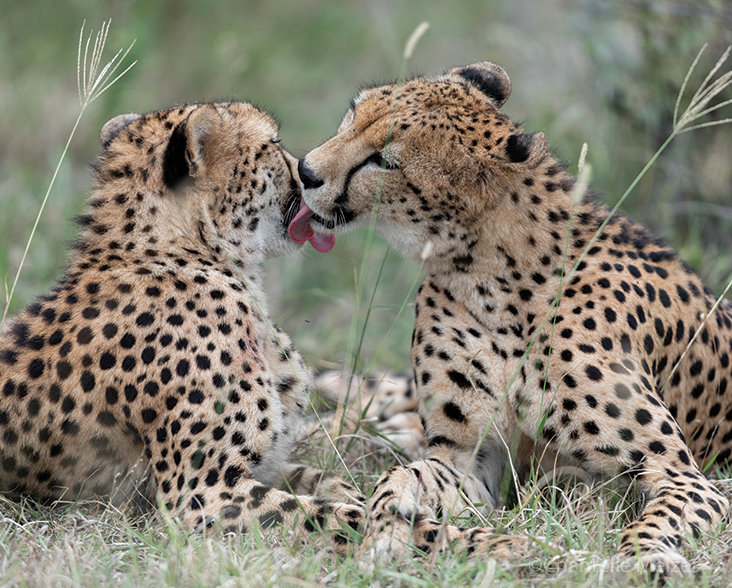Cheetah
Species Data
Class: Mammalia
Order: Carnivora
Family: Felidae
Scientific Name: Acinonyx jubatus
IUCN Red List status: Vulnerable
Description
With its slim, greyhound-like build and relatively long legs, the Cheetah is built for speed and is the fastest land animal in the world. Standing 67-94 cm at the shoulder, Cheetahs have a body length of 112-150 cm, with the tail accounting for between 60-80 cm of this. Adults weigh 21-72 kg, with males averaging larger than females. Four subspecies are recognised.
The coat lacks rosettes but has an individually unique pattern of black rounded spots of roughly the same size on a pale fawn to whitish background colour, the ventral surfaces paler than the dorsal surfaces. The rounded head has small, rounded ears, a faint black vertical line on the forehead, and a characteristic bold black line known as a ‘tear-mark’ running from the anterior corner of each eye down the side of the short muzzle to the corner of the mouth. The long tail is spotted, with black rings on the posterior third terminating in a white tip. The paws are narrow compared to other cat species, and the Cheetah is the only cat without fully retractable claws with no protective skin folds, leaving distinctive footprints with visible claw marks. Each paw has four claws, with the front paws also possessing a dewclaw. Once considered a different subspecies, the King Cheetah is an aberrant colour form with black spots joining to form lines and blotches.
Cubs weigh 250-300 g at birth and have a long greyish mane on the head, neck and back, gradually lost throughout adolescence. In the wild, Cheetahs live for 6- 8 years, with females typically living longer than males.
Behaviour
Cheetahs occur singly, in pairs, or in small family groups consisting of a female with cubs or sociable coalitions of 2-3 usually related males. Male coalitions are resident and territorial, each male scent marking the territory by urinating or defecating, claw raking, claw scraping, and rolling to flatten patches of grass. Non-territorial males are solitary and nomadic, ranging widely and frequently moving after dark to avoid territorial males. They are typically adolescent males, old animals, or adult males not part of a coalition and tend to be less relaxed and have a lower body weight than resident males. Adult females, solitary when without dependent cubs, are also territorial and have much larger territories than male coalitions, which they scent mark by urinating or defecating but do not defend against other females. Home ranges are between 50-130 km2.
This mainly diurnal carnivore hunts alone or with their coalition by stalking prey to within 70-100 m and then sprinting to make the kill. On a straight run, Cheetahs reach speeds of up to 120 kph (75 mph) and, thanks to their long flexible vertebrae, can increase their speed by an incredible 10 kph (6 mph) in a single stride. However, they can only sustain this speed for a few hundred meters, and most hunts are unsuccessful. The main prey species are small to medium-sized ungulates, including Thomson’s Gazelle, Kob, and Impala, with larger species like wildebeest and small animals such as hares and ground-dwelling birds also taken. Where prey is migratory, females and non-resident males follow the herds. Cheetahs rarely scavenge.
Males and females mix only when mating. Males mate with as many females as possible and females with as many males as possible, including more than one individual in a male coalition. Breeding occurs throughout the year, and males play no part in raising the young.
After a gestation period of 90-95 days, females give birth to an average litter of three cubs (up to six in the wild). Mothers keep their cubs hidden from predators in tall vegetation or a rocky outcrop for around eight weeks. Females with dependent young need to hunt daily and often carry their cubs to new hiding places before leaving them to hunt. Cubs are weaned between 3-6 months old and accompany their mother until 15-17 months old when they become independent. Life expectancy in the wild is up to 8 years, with females typically outliving males.


Habitat
Cheetahs inhabit a range of habitats including grasslands, savannahs, thick scrub, light woodland, deserts such as the Sahara, and farmland.
Historically distributed across Africa, the Middle East, and South-West Asia as far east as India, this species is now found mostly in southern and eastern Africa. In Asia, the Cheetah now persists only in Iran.
Threats and Conservation
Now found in only 9% of its historic global range, the Cheetah is one of the world’s most threatened big cat species. The total global Cheetah population is estimated at around 6,517 mature individuals. However, Cheetahs need vast home ranges of between 600-1,000 km², with some more than 3,000 km², and occur in low population densities with rarely more than two individuals per 100 km², making population estimates extremely difficult. Population trends are largely unknown; however, where quantitative data exists, the majority of the known Cheetah population is in decline and severely fragmented.
Historically, Cheetahs were captured for use in hunting, a leading cause of their extinction in Asia. Although this species has been on Appendix I of CITES since 1975, cubs are still taken from the wild for the illegal pet trade, especially in the Gulf states, with most poached from East Africa, and Cheetahs are killed for their skins for the global fur trade.
Most Cheetahs live in unprotected areas, exposing them to threats such as habitat loss and fragmentation due to infrastructure development, mining, and oil extraction, prey reduction due to hunting and grazing of high livestock numbers, human-wildlife conflict with livestock farmers, mortality on high-speed roads, and unregulated tourism. Many of the countries in the Cheetah’s range lack resources and funding for conservation as well as incentives for local people to protect wildlife. Therefore, this species is categorised on the IUCN Red List as Vulnerable.
